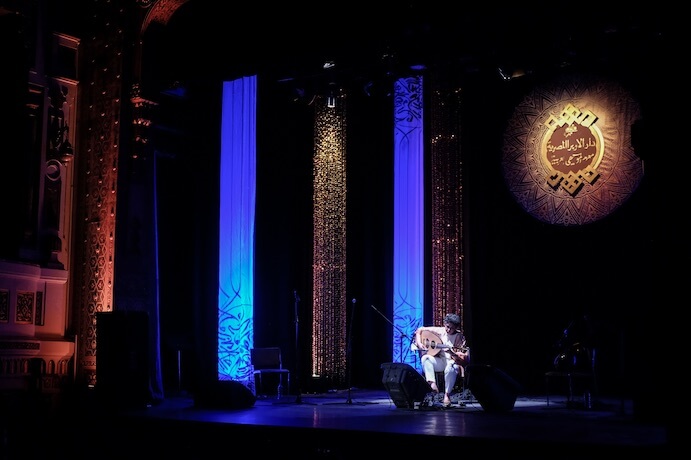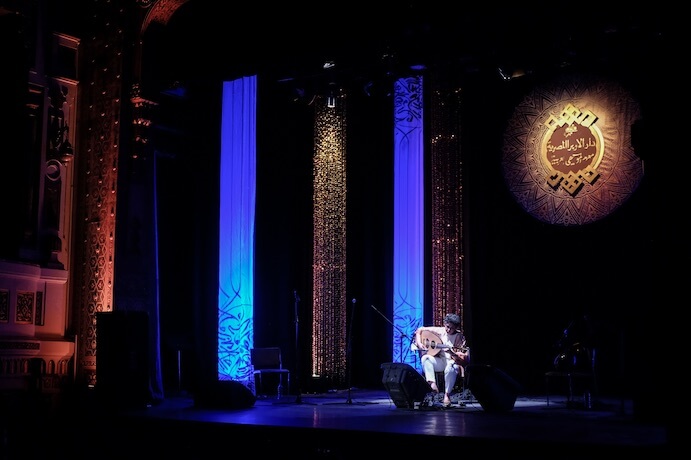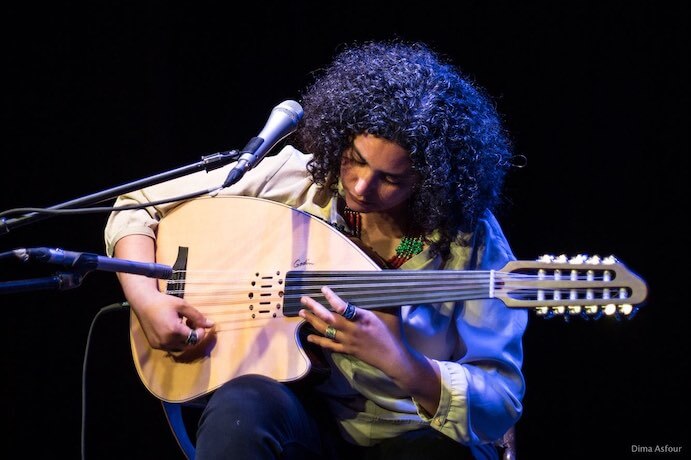
Creatives all over the Arab world are using their talents to define themselves as a people and raise awareness for the oppression they face. One of the clearest examples of artistic resilience in inhumane conditions is the music scene from Palestinians and the diaspora. Palestine is under brutal occupation. Its people’s right to travel, build housing, run businesses, live without fear of arrest, and sometimes live at all are heavily restricted by a settler-colonial regime. The ongoing nakba began in 1948 with the violent removal of 750,000 Indigenous Palestinians from their homes and continues to this day with the forced eviction of residents in Sheikh Jarrah. Meanwhile, in Gaza, the Israeli military have terrorized residents as they strategically destroyed their media, schools, homes, and medical centers.
Despite this catastrophe, Palestinians and their supporters across the globe are anything but silent. In searching for personal meaning in these conditions, new artwork emerges that transcends the boundaries placed on its people. The result is a generation of musicians like Huda Asfour, who brilliantly fuses the traditional with the contemporary to establish a borderless identity in her music. This personality is heard clearly in her 2018 album, Kouni كوني, a brilliant conglomeration of traditional and contemporary Arabic and Jazz styles that explore the artist’s multifaceted experiences. These varying influences are made profound by her life’s journey growing up in the Israeli invasion of Lebanon, later moving to Tunis, and studying in Palestine and Egypt before arriving in the United States. Asfour is a brilliant composer and a virtuosic oud player, singer, and improviser. In understanding her musical diversity, one also gets a taste for the modern Arab identity — one that knows where she comes from and dares to dream forward.
What have you been working on in the past year?
I think like many, events are currently defined as pre- and post- this pandemic. Right before our lives shifted so dramatically, I had received the Artist Grant from Mophradat to conduct a series of improvisational concerts and workshops for ensembles based on aesthetics from the Arabic speaking region, mostly folk and Maqam music, which I am most drawn to as a composer and improvisor. I spent the first stage of the research in the USA, and between March – October 2020, I delved into readings on improvisations, both from a pedagogic perspective, as well as the social and physiological impact this practice can have in transforming the way we listen deeply and the ways we communicate. I spent time developing curricula for improvisational skills more broadly, as well as studying conducting languages and the music styles that resulted from these practices. As soon as we could fly again, I headed to Egypt and led a few workshops on improvisational skills for Arabic music in Cairo and Alexandria.
I have also had the fortune to record improvisational gatherings and duo improvisations with some of the prominent improvisers in Cairo and Alexandria, and lately in Baltimore, as well. I hope that the recordings of these collaborations will be available before the end of the year, for a larger audience, as a project titled Mortajal (Arabic for “improvised”), along with interviews and some reflections on my time in Egypt this last year.
More recently, along with a group of five other musicians from the Arab region (Maurice Louca, Aalam Wassef, Aya Metwalli, Rehab Hazgui, and Sam Shalabi), I finished working on a kids album, commissioned also by Mophradat. I arrived in Cairo again in early August, and I will be in Egypt for the next few months teaching, performing, and working on some new music productions.
You recently performed in Cairo, where the 1932 Congress of Arab Music occurred. How does your current music relate to this historic event?
The theater at Ma’had al Musiqa al Arabiya, originally the first music school dedicated to teaching Arabic music, is truly a stunning venue, both visually and acoustically. The 1932 Congress of Arabic Music, on the other hand, is a controversial event in the history of our region and its music. There is no doubt that the archival material that was recorded then remains the largest documentation of the music flavors played in the region, although some of the choices that were made in the selection were questionable for many. It was also the first and most daring act in trying to standardize Arabic music modalities and intonations, according to Western theory and notation. Prior to this moment in history, there was no such thing as “Arabic music,” per se. Music was oriental. But after the fall of the Ottoman Empire, there seems to have been a need to distinguish “this music” (Arabic) from Turkish music and other oriental styles. But the truth is that the different music dialects present in the region did not necessary cross talk before then. There are many stories about debates on the standardization of intonation and the loss of some of the nuances. Many of the questions I am exploring as a musician and educator are related to the ways we keep this heritage alive, relevant to the contemporaneity of the sonic experience for us as global listeners and practitioners of music.
In that sense, to bring back an improvisational project more classical in its aesthetics despite its free form, was a unique opportunity. Not to mention the beauty and charm of the theater itself and the caliber of the musicians I had the honor to play with. For me, these are some of the most exciting improvisers of my generation (Nancy Mounir, Aly Eissa, Mohamed Sawwah, and Ayman Mabrouk). To imagine that many of the most notable musicians of the 20th centuries have performed on that stage was exhilarating.

Huda Asfour at the Arabic Music Institute–Photo by Ziad Hassan
What inspired you to write Kouni كوني?
For this album, the inspirations were multilayered, actually. Sonically, I was exploring new sounds. Thematically, I was resentful about the limits we put on the possibilities of the human experience, especially when it comes to love and desire. It was also an exploration of my identities. I also wanted to write a pop album that did not sound so pop.
I started working on Kouni shortly before the release of my debut album, Mars Back and Forth, in 2011. I was working in D.C. with Brian Falkowski, who played clarinet and saxophone, and had recently met multidisciplinary artist Asha Santee, who played drums and percussion with us, and Derek Bond on electric bass. It was an exploration of a new sound for me. In a conversation with my friend Nehad Khader, who lived in Iraq during her childhood, I asked if she would like to sing some of the popular folk songs rearranged for these instruments. The result was a groovy, happy vibe. I remember the euphoric feeling I had when I saw people dance in the venue the first time we performed these songs. So sonically, I really wanted to explore new sounds for my music, and I was fascinated by the depth of textures and emotions one can produce with strings and brass instruments.
At the same time, on a personal level, it was a time of exploration of my identities. When I started working on the album, I was struggling with the idea of having to define myself via labels. The list seemed long. I carried within me pieces of Palestine (the parts I could visit and those I could not), Tunisia, Egypt, and even Iraq by proxy via my mother who grew up there. In those years, I was also confronting the limits societies put on love and our expression of it. I had to assume labels to explain how I loved and who I loved. It seemed exhausting and completely unnecessary. The working title of the album then was “Mosaic Identity.” After writing the song Kouni (which is the feminine version of the imperative “Be” in Arabic), I felt this album transform into an embracement of these identities, into one whole sense of self. At least it was the beginning of the process. I also perhaps came to understand how important these labels are for the visibility of the larger community that sees itself as part of a larger spectrum of existence. Kouni, in a sense, was an album for unconventional love. I really believe that borders imposed on the human experience by societies are limiting the beauty we are capable of producing as a species.
How did you get started in music?
For as long as I remember, music was part of my upbringing. I am very fortunate to be part of a musical home, through my mother. She loved music and worked hard for me to have access to music learning. My grandfather played the Oud and had a voice reminiscent of Mohammad Abdel Al Wahab. I learned recently that he picked up the oud because his sister (Ruqayya) bought herself an oud with her first salary as a teacher in Akka in the 1930s. I also learned that my great grandfather was an oud player, who did not own an oud for years, not until Ruqayya brought one.
A few years after the Nakba, my grandfather decided to settle in Iraq, where he worked as communication engineer for the Iraqi petroleum company. My mother grew up in Iraq, and spent many years in Baghdad. During my childhood, we lived in Tunis, and the rest of my maternal side of the family were in diaspora between the USA, the UK, Iraq, Syria, Kuwait, and Jordan. Although we were rarely in the same place, I had access to recordings from the 70s of the family singing my aunt’s compositions of leftist Arab and Palestinian poets. I also had heard recordings of my grandfather and all of my aunts singing together like a trained chorus.
There are photos of me playing a keyboard at two-years-old in Syria. At the age of four, I remember singing many of the Rahbani repertoire my mother listened to, and by seven, I was writing songs, singing as part of the school activities, singing many of the songs from what we call Muqawama songs, but I loved songs by the Palestinian group Sabreen the most. The voice of their lead singer Kamilya Jubran was different than anyone I had heard, and Said Murad’s compositions were fresh. I had also started learning piano, which did not last long because I found the methods to be unpleasant. It wasn’t until I started middle school in Tunis where I met a teacher that changed my desire to study music again: Mr. Hisham.

Huda Asfour–Photo by Dima Asfour
Soon after, I experienced the first family reunion on my mother’s side in Amman. My uncle was getting married, so everyone flew to meet the bride and her family. My sister and I were able to get a visa, which was not precedented before. There, I got to truly spend time with my grandfather and meet him more closely. I was mesmerized by the sound of the instrument, his knowledge about Maqam, by the power of that instrument in bringing people together to sing communally. Anyone who knew he was in Amman wanted to be there to participate in this very special gathering: by singing, dancing, or just listening. When we returned to Tunis, I started a discussion with my teacher, and shortly after, I was registered at the conservatoire, where my formal training in music started, and continued later in Gaza with Ibrahim El Najjar and after that in Ramallah with close mentorship from the unique Palestinian thinker and composer Khaled Jubran, and ironically the brother of Kamilya Jubran, who I grew up listening to.
How does your background in Palestine affect your work?
You know, they say “the personal is political.” Especially for people of the global south, this statement could not be more true. Writing music for me is my form of storytelling and a venue to reflect emotions and intense experiences. In that sense, being a Palestinian is very much tied to all my work. My work is a reflection on my exile, the search for the meaning of home, the history we carry through ancestors, and the connections that form within the diaspora and a global community of supporters of Palestine.
Living in Palestine between the age of 14 and 20 was transformative from a pedagogic perspective because of my training with Khaled Jubran. It was also in my freshman year of college in 2000 that the second intifada started. It was years later that I would release Mars Back and Forth, which was my narrative of those years in Palestine. It was in Palestine that I started dreaming of a world without borders. I just don’t believe in these cutoff lines that are supposed to unite us. Perhaps it is because I am Palestinian that I appreciate the freedom of movement even more.
The anger that came with the second intifada had no room in my traditional music upbringing, so I started, with the help of my mentor and with my music partner at the time, Tamer Abu Ghazaleh, re-exploring arrangements of old Arabic repertoire that reflect the depth of the emotions we felt as two young Palestinian musicians who had just experienced a siege and survived a military war lead by the Israeli Occupation Forces.
The experience of the intifada for me, the rage I felt as a university freshman, the community we built to be able to survive, learning to fight through art — all these experiences shaped who I am today. From an early age, art has been a tool for awareness, for conveying realities that otherwise go undocumented, and for helping people deal with pain, speak against injustice, and hopefully it can also help us heal.
I CARE IF YOU LISTEN is an editorially-independent program of the American Composers Forum, funded with generous donor and institutional support. Opinions expressed are solely those of the author and may not represent the views of ICIYL or ACF.
A gift to ACF helps support the work of ICIYL. For more on ACF, visit the “At ACF” section or composersforum.org.


